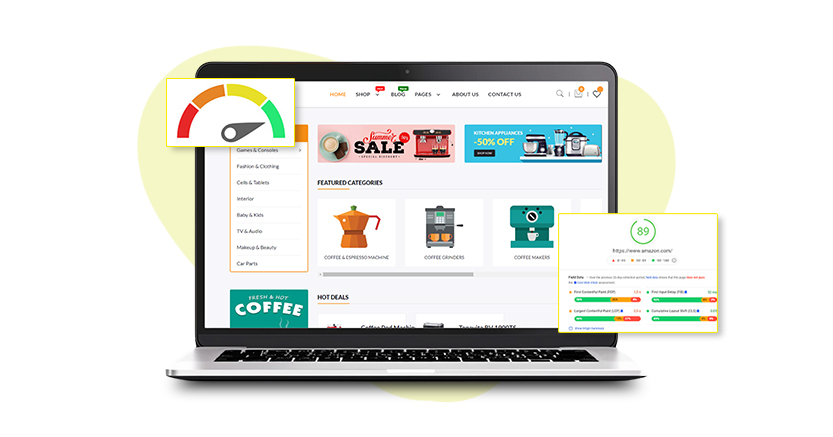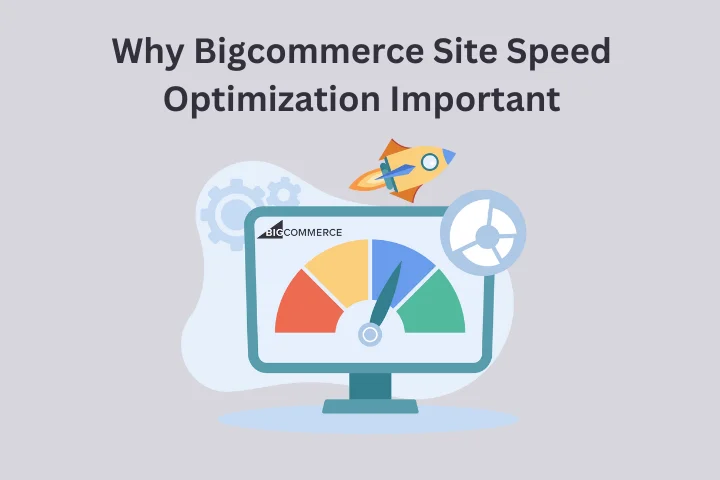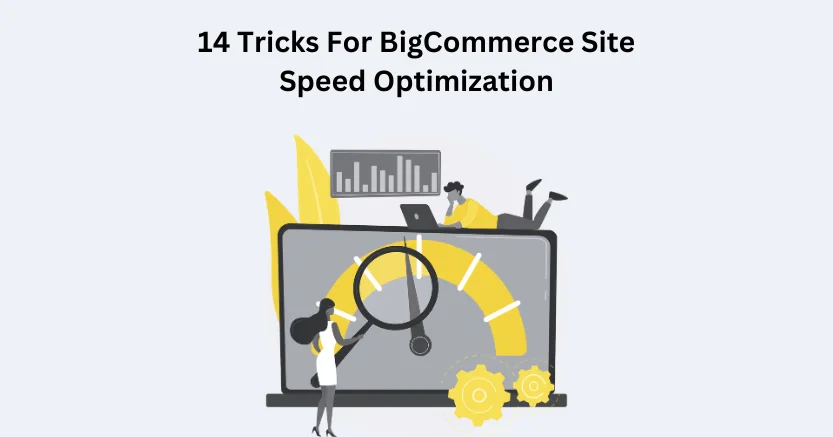Introduction
BigCommerce is like a helpful online shop builder listed on NASDAQ. It gives retailers tools for creating stores, being easily found on the web, hosting, and handling marketing and security. It works for all kinds of businesses, from small ones to really big ones.
Building a store on this platform can boost your brand awareness and visibility due to its extensive reach. Additionally, the loading speed of your website contains a unique value that impacts the various aspects of your business performance, including conversion rate. So, for BigCommerce conversion optimization, the crucial element is website load time optimization. They are both interrelated and vital for excellent business reach, ranking, and recognition.
Thus, in this blog, we will explore the top ways to improve your website loading speed.
What Is Page Loading Speed?
The term “page speed,” often referred to as “website load speed,” describes how quickly a page loads its content. Quick page loading is essential for good SEO. Page load speed is influenced by several elements, including page size and web hosting.
Now, move further towards website speed optimization techniques, as they are important for sales.
How To Improve BigCommerce Site Loading Speed?
Optimize Your BigCommerce Store Speed for Better Results Now!
Speed Up Your BigCommerce Store NowHere, you can explore practical steps to enhance the loading speed of your BigCommerce website for a smoother user experience and improved business outcomes :
Optimizing Caching:
In simple terms, imagine a little helper keeping some extra information in the cache. This information helps you guess the direction or specific block for the next time you want something from the cache. The bits decide which block to check next. When it comes to caching, the game plan is to store copies of your web files on a user’s device. This trick kicks in when someone revisits your site, making things load faster. The idea is to ease up on the server workload and give users a smoother experience Therefore, optimizing caching is crucial for website speed increase.
Optimizing CSS Delivery:
Getting CSS delivery up to speed means only sending the styles that truly matter for a page to show up. This cuts down on loading time, especially for those with slower connections. By tidying up and minimizing CSS files, you ensure your website displays seamlessly and swiftly. Keep your selectors simple when writing code. Don’t go overboard with animations, as they impact your website speed; use them wisely. Be mindful of when to animate costly properties. Make sure your files aren’t too big—optimize their sizes. Skip using base64 for bitmap images. Compress your CSS to make it more efficient. And, for CSS, consider lazy loading—loading it only when needed for better performance.
Reducing Redirects:
In speedy page loading, minimizing redirects is a key move. Redirects create extra requests, causing a delay in content delivery. Simplifying your website structure minimizes unnecessary redirects, giving a boost to overall speed. Stay away from connecting to links with redirects, as it contributes to increasing website speed. This is the situation that arises when you manually build a link but leave the text link referring to the new resource unchanged. To access any of the resources, you don’t need to establish several redirects. For BigCommerce conversion optimization, minimizing the redirect is an essential aspect.
Deferring JavaScript Loading:
The best way to load a script is by using something called the “defer” attribute. It’s a bit like another attribute called “async,” but there are some important differences. Delaying the loading of non-essential JavaScript until a page is fully loaded ensures that crucial content pops up quickly. This tactic is particularly handy for mobile users and those dealing with slower connections. So, your webpage keeps loading smoothly even if the script is still working behind the scenes, and contributes to website speed increase.
Minifying Your Code:
The practice of eliminating all superfluous characters from JavaScript source code without compromising its functionality is called reduction or minification. This entails using shorter variable names and methods and eliminating semicolons, whitespace, and comments. Minifying code is like tidying up a room – it involves removing unnecessary characters, spaces, and line breaks. This streamlines the code, making it load faster and giving a nice boost to overall page speed. It’s a simple yet effective method for enhancing website performance.
Reducing Server Response Time:
Choose a reliable hosting service for your website. Invest in a good bot management solution to handle traffic. Trim down unnecessary stuff and make your resources lean. Make sure your database is in top shape for smooth operations. Speed things up by using pre-fetching. If possible, avoid using web fonts to keep things moving quickly. And lastly, keep everything up-to-date to ensure your site stays in top-notch shape. These simple steps can go a long way in making your website fast, efficient, and problem-free. Optimize server settings, database queries, and hosting to shrink response time, guaranteeing a snappier user experience. Additionally, for BigCommerce conversion optimization, this is an essential strategy.
Getting Rid of Unnecessary Plugins:
For BigCommerce conversion optimization, plugins may be removed in a single step. After deactivating the plugin, select “Delete” to fully erase it from the server and directory. Carry out a bulk deletion if the list of inactive plugins is lengthy under the Inactive tab. Alternatively, repeat the process for all the plugins you no longer require. Unused plugins can be like extra baggage, slowing down your website. Regularly audit and remove plugins that don’t pull their weight. A leaner set of plugins means a more streamlined performance and increased website speed.

Want to read this blog offline?
No worries, download the PDF version
now and enjoy your reading later…
 Download PDF
Download PDF Content Delivery Network (CDN):
The use of a content delivery network (CDN) is one method to increase website speed. In order to minimize delay and length between the initial server and the ultimate user, a content delivery network, or CDN, is a network of computers that delivers online content to users based on their geographic location. A CDN is like having multiple copies of your website’s static content scattered across servers worldwide. This smart move cuts down on wait times and speeds up content delivery, ensuring users across the globe enjoy faster page loading with enhanced website speed.
Optimizing Images:
Optimizing images is all about compressing files and choosing the right formats. For this, first check your website speed. Pick the right image type. Resize before exporting. Compress to shrink the file size. Try a WordPress plugin for automatic optimization. Use the “blur up” trick to load a quick, lower-quality image first. For website speed increase, following these tricks is essential. This trims down image sizes without sacrificing quality, resulting in quicker loading times.
Minimizing HTTP Requests:
Every element on a webpage throws in an HTTP request. Boost your website speed with simple tricks: Combine CSS & Javascript, minify code (HTML, CSS, Javascript), enable lazy load, ditch unnecessary images, shrink image sizes, turn off extra plugins, and cut down on external scripts. These tweaks make your website speed increase, ensuring a smoother user experience. Minimizing these requests, whether by combining files, using sprites, or trimming down elements, ramps up website speed and plays an important role in BigCommerce conversion optimization.
Checking Page Speed:
Regularly sizing up your website speed, perhaps with tools like Google PageSpeed Insights, is a savvy move. It helps pinpoint areas for improvement, ensuring your site stays in top-notch shape. Additionally, to test your website speed, open Chrome or Firefox and navigate to the webpage you wish to examine. Then, right-click and choose “Inspect.” Open the pop-up window and select the “Network” tab. You can see all the information, including the load time, as your web page loads.
Comparing Hosting Providers:
Choosing the right hosting provider is a big player in the online marketplace game as it is critical for the website speed increase. Weigh providers based on server performance, support, and features to ensure your website glides smoothly. To compare different website hosting provider, know their pros and cons, and then select the best according to your brand needs. For BigCommerce conversion optimization, choose the hosting provider that comes under your budget, fills the gap, and boosts your store performance by providing additional features.
Minifying Your Files:
The practice of reducing the amount of code and markup in your script files and web pages is called minification. It’s a primary technique for BigCommerce conversion optimization, cutting down on website load times and bandwidth use. Minification significantly increases the loading time and usability of websites, which immediately enhances the browsing experience. It’s about trimming down various file types, from HTML to CSS and JavaScript. Smaller file sizes mean faster website speed increases and an all-around improved performance.
Conclusion
Therefore, in this blog, we have explained the basics of speed and BigCommerce. After that, we explained the top ways to boost BigCommerce website loading speed for best performance and high conversion rate. Also, to improve speed in minutes without performing any method, utilize the effectiveness of BigCommerce page speed optimization tool, Website Speedy, a SaaS-based tool to improve the website’s loading speed in minutes by fixing issues such as render-blocking, fixing Core Web Vitals, and do everything to make your website load faster with enhanced performance.
December 29, 2023
Leave a Comment
















































